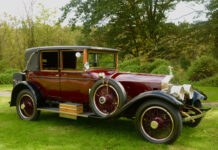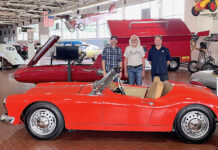By Corey Frederick
Walking around a car show or local cruise-in can simulate taking a stroll down the proverbial memory lane. Mike Overcast’s 1967 Chevrolet Nova SS did just that for me. It activated my imagination and caused me to reflect on memories that I had from my childhood, riding in a Nova and hoping that we made it from one destination to another without running out of gas (the fuel gauge had long stopped working). Many of us have similar memories and seeing certain cars can kick those thoughts into overdrive.
My personal reflections aside, Overcast’s 1967 Chevy/Nova SS is by leaps and bounds much better than the one in my past. Only slightly modified, Overcast’s vehicle is a great example of what the car would have originally looked like on the outside. But before we explore this wonderful example, let’s look at the history of the Chevy II/ Nova.
In the early 1960s, America’s compact-car market was booming. All in 1960, Ford produced the Falcon, Mopar introduced the Valiant, and General Motors manufactured the Chevrolet Corvair. However, what caused GM to return to their drawing board was that the Falcon was more popular than the innovative Corvair. Hoping to regain some of the market, GM designers delivered an idea for a more conventional compact automobile, which was named the Chevy II. Instead of the Corvair’s air-cooled rear-engine design, the Chevy II/Nova would have a front engine that was water-cooled, and it would be rear-wheel drive.
Ushering in the first generation of the automobile, production of the Chevy II/Nova began, and the first models rolled off the assembly line in 1962. The base model of the vehicle came with a four-cylinder 153 cubic-inch engine, but buyers could upgrade the motor by replacing it with the optional six-cylinder 194-ci power plant. Additionally, the original Chevy IIs could be purchased in four different body configurations: a four-door sedan, a two-door coupe, a station wagon, or a convertible. In this first year, the convertible was the most popular configuration, since it could be purchased for just over $2,400.
The 1963 production year saw the birth of the Super Sport model of the Chevy II/Nova. This particular car boasted the 194-ci engine, along with special trim options and stiffer steering. What’s intriguing about 1963 models is that it would be the only year that the Chevy II SS was offered in a convertible option and the last year for Chevy II/Nova convertible.
It wasn’t until 1964 that the Chevy II/Nova offered an optional V8 283-ci motor, which made 195 horsepower with 285 lb-ft of torque. Although this was not the highest amount of horsepower on the market, the car’s weight-to-power ratio still made the car quick on the streets. But even with more horsepower, sales figures of the 1964 model slumped after the introduction of the Chevrolet Chevelle into the mid-size car market.
The Chevy II/Nova launched itself into the muscle-car arena with the additional engine options in the 1965 production year. This was the first year that the V8 327-ci motor – offered in 250 hp and 300 hp variations – was an option for the car. This 300 hp engine paired with the vehicle’s light weight and close ratio gearing caused enthusiasts to begin drag racing the automobile against some of the faster production cars of the day, including Mustangs and GTOs.
During the next production year, GM gave the car a much-needed facelift, causing the 1966 and 1967 models to be considered the second generation of the Chevy II/Nova. In 1966, GM designers implemented noticeable modifications to the car’s exterior, in addition to expanding its engine options. To appeal to the muscle car market, the storied L-79 engine, still at 327 ci, became available, making the automobile capable of producing 350 hp. As a wildly-popular automobile, over 16,300 of the Chevy II/Nova SS models were manufactured in 1966.
The second and last year of the second generation of the Chevy II, 1967’s model was outfitted with a new grille and side trim. A dual-reservoir braking system became standard, but buyers could upgrade to disc brakes as an available option. Although GM made several improvements to the automobile, the manufacturer dropped the L-79 option on the car to avoid taking sales away from the new Chevrolet Camaro. This variation of the 327-ci engine, named the L-30, was available in the SS version of the car, but it produced 275 hp. Just over 6,100 of these SS models were built during that model year.
Flash forward to the present. Mike Overcast is the third owner of one of these 1967 Chevy II/Nova SS automobiles. The vehicle itself was originally purchased in 1967 as a present from a father to his son, who had just graduated from the U.S. Naval Academy. The son stayed in the U.S. Navy for 28 years, but as he was leaving the Navy, he sold the vehicle to a fellow naval officer. The second owner then relocated along with the vehicle to Palm Coast, Fla., where the automobile stayed until 2003, when Overcast purchased it from the owner.
The exterior of the car is in near-perfect condition. The Ermine White paint, which was the car’s original color, was repainted in 2003 to the exact same color, and its chrome, as well as additional exterior trim, has been refreshed. The car even has the chrome 327 emblems, which are located above the V-flag emblems on its front fenders on each side of the vehicle.
With the same intentions to maintain its factory looks, Overcast has kept the interior of the car as original as possible, except for an added sub-dash with extra gauges. The gauges in the main dash as well as the door panels are all original. However, Overcast had to have the Nova’s red seats reupholstered around 2003, but he matched them to the original color. Painstakingly matched as well, are the replacement headliner and the dash pad.
As for what’s under the beautiful exterior, the 1967 Chevy II/Nova SS still sports a rebuilt 327-ci engine, but the transmission was exchanged with an automatic 700R4. When the engine itself was rebuilt, Overcast had a 270 competition camshaft installed, the pistons and rings coated in Teflon, and the engine bored .030 over. While upgrading the front suspension, Church Boys Racing components were installed for sportier handling.
With all of its pristine original features and subtle upgrades, looking at Mike Overcast’s 1967 Chevy II/Nova SS is almost like looking into the past, peering into a treasure trove of memories. This is especially true for the car’s owners, and it can definitely have that effect on any unsuspecting observer. •



